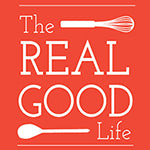
Eco-Friendly Practices of The Real Good Life
Last week I told you all about what I, as a human, am doing to protect the earth in hopes it inspires you, but this week I’d like to tell you about our eco-friendly business practices here at The Real Good Life.
First up, the food. Oh my, the food! As our estimating and ordering systems get more refined, we are able to order exactly what we need. Usually we don’t end up with too many extras, but we’ve also started planning out menus to use up what we’ve got. You should see our freezer! Also, here’s an insider tip – when you see roasted vegetable soup on the menu (cough, next week, cough), you know we assumed to have a bunch of extra veggies to use up at that time. Any extra herbs or peelings that can’t be used in an actual dish get put into homemade vegetable stock made every week.
We get our food from three or four resources. Y’all have told us that organic and local aren’t necessarily a priority, but we purposely gather our needs from these four places because frankly, they can give us the most all in one shot. We have most things delivered so gas isn’t wasted chasing around odds and ends.
At the end of each week, we divide up any small portions of extra food or ingredients that are past their prime but still usable (I’m looking at you apples with brown spots!) amongst the employees. If we misjudged and have a bunch of leftovers of one dish, we’ll usually donate to the Ronald McDonald House.
We have signed up with Compost Crusaders so we can compost all of our food scraps – bones, fat, sauces, and dairy get thrown in with the produce scraps and eggshells. Have you heard of this program? It’s gotten so popular so fast that we aren’t able to include paper towels or kleenex anymore, so we try to use reusable rags whenever possible.
Speaking of kitchen cleanliness, there is no getting around using plastic gloves when we touch raw meat or fresh ingredients like salad fixings. If you find something that passes muster that works, please let us know! It makes me sad every time I have to toss a glove after 30 seconds of handling a product.
Most of our food comes in cardboard boxes or those large #10 cans. We recycle anything that can be, even going as far as taking recyclables home when the kitchen bins are full.
Once the food is ready, we set up delivery routes that take the drivers on the most efficient path, saving gas and emissions. Also, as you know, we deliver our food in reusable cooler bags with reusable ice packs. We trade those out with your next order, but hope that in the meantime you use them for your own grocery runs or picnics.
As the bags get too ratty for us to use, we donate them to the Bring Your Bag Shorewood program. These folks sew up any imperfections and put the bags out at the grocery stores and library in Shorewood so people don’t have to use plastic bags.
A Note about our packaging
All of that said, let’s talk about the elephant in the room – our plastic packaging. From day one of the business, I’ve tried non-plastic options. Unfortunately, nothing works as well. Simply put, the plastic holds up better to refrigeration, soggy soups, and if you’re down with it, microwaving. The compostable or bamboo products we’ve tried just don’t work for long periods of time. Also, as our contact at Compost Crusaders pointed out, these compostable products can only be industrially composted (so no backyard bins). As I mentioned above, they as the area’s one industrial composter, are no longer taking “non-nutrient” items so we couldn’t even put them there. Even sadder – if thrown into the regular trash, compostable products will take just as long as other garbage to disintegrate in a landfill due to lack of oxygen.
The next option is glass. On one hand, this would make the bags significantly bulkier requiring more delivery drivers out on the road (and a much more expensive product as we’d have to keep that inventory). On the other, the Wisconsin health department says no glass in a commercial kitchen*, so… Nope.
Our plastic products do take resources to make and to recycle, but at least in theory, can be recycled. (Also great to keep as your own set of giveaway leftover containers!) So while we wait for an energy-efficient alternative product to come out, we’ll continue to use these. P.S. In a week or two we’ll be on to new labels that are easily removable, so easier to run through the dishwasher.
Our metal casserole containers can be recycled as well.
* You may see glass containers from other similar services. I’ve found that each health inspector has different answers to the same questions. Unfortunately, I’ve already asked ours about glass, so he’s on to me. 😉 Also, I’ve asked if we can have you send back your plastic containers to reuse, to which he sent the exact statute that also said… Nope. Wah wah.
Would love to know your thoughts on our practices or ways you think we could improve. We are ALWAYS here for your suggestions on other packaging products to try!
Happy recycling, friend.

